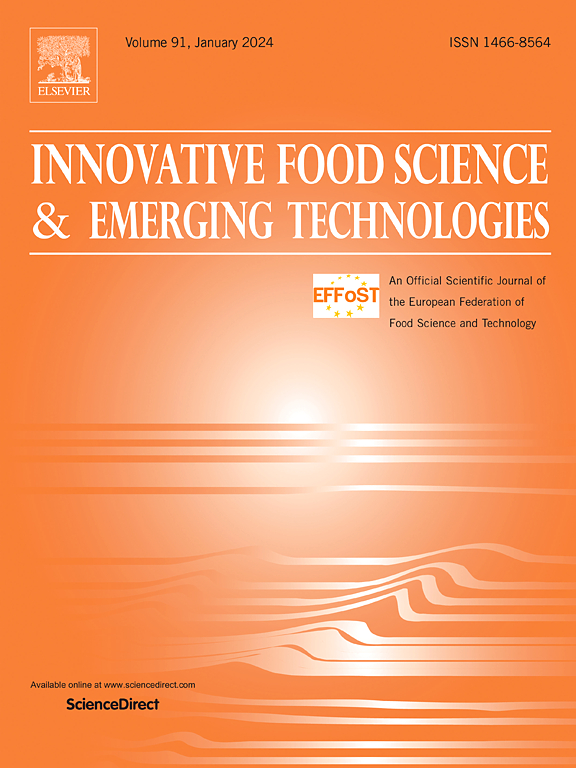New insights into the repair mechanisms of sublethally injured Staphylococcus aureus induced by ohmic heating: A joint analysis using transcriptomics and metabolomics unveils wave-like repair pattern
IF 6.8
1区 农林科学
Q1 FOOD SCIENCE & TECHNOLOGY
Innovative Food Science & Emerging Technologies
Pub Date : 2025-06-14
DOI:10.1016/j.ifset.2025.104085
引用次数: 0
Abstract
Current studies on the repair mechanisms of sublethally injured bacteria are primarily limited to the macroscopic level, focusing on factors such as repair conditions and medium composition. This study addressed the gap by exploring molecular-level repair mechanisms. Ohmic heating (OH), an innovative and efficient thermal processing technology, has demonstrated effectiveness against foodborne pathogens such as Staphylococcus aureus (S. aureus). However, OH can also produce sublethally injured bacteria that may recover under suitable conditions, posing potential food safety risks. These injured cells can potentially recover in suitable environments, posing risks to food safety and consumer health. This study aimed to obtain comprehensive biological information by applying 50 Hz and 10 V/cm treatment, which raised the temperature to 55.5 °C and resulted in a sublethal injury ratio exceeding 95 %. Subsequently, the repair mechanisms of OH-induced injury in S. aureus were systematically investigated at the transcriptional, metabolomic, and proteomic levels. The results revealed 1386, 962, and 633 differentially expressed genes (DEGs), along with 423, 305, and 264 differential metabolites (DMs), during the injury, initial repair, and mid-repair phases, respectively. Further analysis of crucial DEGs, DMs, and proteins revealed that significant pathways related to cell membrane integrity, lipids, and energy metabolism were suppressed post-injury, showing marked recovery in the initial repair stage, followed by a downtrend in the mid-repair phase, displaying a “wave-like” pattern. Additionally, transcriptional and translational functions of injured S. aureus cells were initially suppressed following injury but showed sustained enhancement throughout different repair phases. These dynamic changes provide valuable insights into the sequential repair processes and biologic metabolic adaptations in injured bacteria. This study advances our understanding of the repair mechanisms in injured S. aureus, and provides novel perspectives into OH application in food processing.
对欧姆加热诱导的亚致死损伤金黄色葡萄球菌修复机制的新见解:利用转录组学和代谢组学的联合分析揭示了波状修复模式
目前对亚致死损伤细菌修复机制的研究主要局限于宏观层面,关注修复条件、培养基组成等因素。本研究通过探索分子水平的修复机制来解决这一空白。欧姆加热(OH)是一种创新和高效的热处理技术,已证明对金黄色葡萄球菌(S. aureus)等食源性病原体有效。然而,OH也会产生亚致命的损伤细菌,这些细菌在适当的条件下可能会恢复,从而构成潜在的食品安全风险。这些受损细胞有可能在适当的环境中恢复,从而对食品安全和消费者健康构成风险。本研究通过施加50 Hz和10 V/cm的处理,将温度提高到55.5°C,亚致死伤害率超过95%,以获得全面的生物学信息。随后,在转录、代谢组学和蛋白质组学水平上系统地研究了oh诱导的金黄色葡萄球菌损伤的修复机制。结果显示,在损伤、初始修复和修复中期,差异表达基因(deg)分别为1386、962和633个,差异代谢物(DMs)分别为423、305和264个。对关键deg、DMs和蛋白质的进一步分析显示,与细胞膜完整性、脂质和能量代谢相关的重要途径在损伤后受到抑制,在修复初期表现出明显的恢复,随后在修复中期呈下降趋势,呈现“波浪形”模式。此外,受损金黄色葡萄球菌细胞的转录和翻译功能在损伤后最初受到抑制,但在不同的修复阶段表现出持续的增强。这些动态变化为损伤细菌的顺序修复过程和生物代谢适应提供了有价值的见解。该研究促进了我们对受损金黄色葡萄球菌修复机制的理解,并为OH在食品加工中的应用提供了新的视角。
本文章由计算机程序翻译,如有差异,请以英文原文为准。
求助全文
约1分钟内获得全文
求助全文
来源期刊
CiteScore
12.00
自引率
6.10%
发文量
259
审稿时长
25 days
期刊介绍:
Innovative Food Science and Emerging Technologies (IFSET) aims to provide the highest quality original contributions and few, mainly upon invitation, reviews on and highly innovative developments in food science and emerging food process technologies. The significance of the results either for the science community or for industrial R&D groups must be specified. Papers submitted must be of highest scientific quality and only those advancing current scientific knowledge and understanding or with technical relevance will be considered.

 求助内容:
求助内容: 应助结果提醒方式:
应助结果提醒方式:


